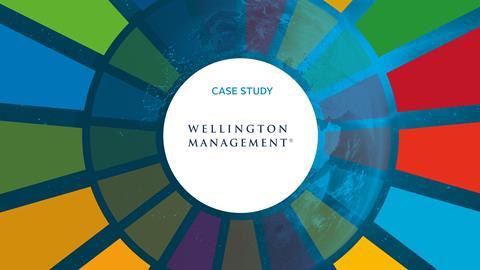Wellington Management
- Investment manager
- US
- Fixed Income (publicly traded municipal bonds)
In our impact strategies, Wellington aims to achieve positive, measurable social and environmental outcomes alongside competitive financial returns. We do this by investing in companies whose core products and services represent solutions not addressed by other nonmarket means.
Why we focus on SDG outcomes
We decided to focus on 11 impact themes before the SDGs were created, and we find each theme aligns well with at least one of the SDGs and its underlying targets.
The process of defining impact themes included collaborating with colleagues from international development organisations, multinationals, the investment community and within academia. This allowed us to leverage insight from a broader set of perspectives and experience. The 11 themes are spread across three major categories – human empowerment, environment, and life essentials.
We believe many of the SDGs, particularly those addressed in our portfolio, represent challenges for which solutions will unlock significant economic value and support a more stable and prosperous global economy. For example, a student’s education can provide tools for long-term career success and self-sufficiency. An additional benefit is the increase in that student’s contributions to their community.
The benefits are multidimensional and often apply to a broad group of stakeholders and society, rather than simply to the direct customers of a product or service. For example, a mobile phone operator’s products and services may equip individuals to start a business or to access education or healthcare.
We see urgency as well as a great deal of opportunity to increasing the capital allocated to environmental and social outcomes.
How we focus on SDG outcomes
Our Global Impact portfolios maintain a high threshold for inclusion, both in terms of impact and return potential. Investment candidates must demonstrate materiality, additionality/contribution, and measurability to be considered for the portfolio.
Materiality: A core focus (i.e. > 50% revenue exposure) must be on products and services solving challenges defined in our impact themes. In the case of green or social bonds, most proceeds (at least 90%) must go towards projects that address our themes.
Additionality / Contribution: The issuer needs to offer distinct value in terms of the challenge it addresses and how it meets the challenge. This could be innovative technology, underserved markets or other distinctive avenues for delivering positive outcomes.
Measurability: We create a theory of change for each investment and identify metrics to measure progress. We ask for outcome-based data from issuers, and where that is not available, we use proxies and estimates, such as peer data or academic research.1 We also rely on data science and new technology. For example, to gain insight on physical climate risk, we combine weather, property and other geographic inputs with Carbon Disclosure Project data.
If evidence eroded or if data points suggested the outcomes we seek are not being delivered or are being significantly diluted, we would reconsider our investment thesis and potentially exit the position.
Example: Identifying outcomes in education
Municipal bonds to fund school building renovation and construction are typically linked to favourable education outcomes for students from low-income communities. Many of these bonds may also offer solid credit fundamentals. We believe that they directly address SDG 4 – Quality Education, in particular SDG targets 4.3 and 4.4, and indirectly contribute towards SDG 10 – Reduced Inequalities, particularly SDG target 10.2.
We identified outcomes based on the criteria described above:
Materiality: 100% of municipal bond proceeds are used for the construction and renovation of primary and secondary schools.
Additionality / Contribution: Funding of school infrastructure improvement projects in a low-income school district in the US.
Measurability: The metrics we seek include:
a) reduction of the learning gap for English learners and students with disabilities;
b) median increase earnings potential with high school diploma in the US;
c) mobility among largest 100 cities in US; and
d) estimated improvements in educational outcomes based on quality education (these could include grades/degrees awarded, employment rates/starting salaries, where available).
For a higher education institution, we would also be looking to understand the demographics of the student population, as well as evidence of the quality of the education provided and whether students can leverage their education for good jobs and income.
Monitoring Progress:
The issuing municipality in this example invested 100% of the proceeds, US$70.6 million, in education with 18 school buildings constructed or renovated, affecting more than 33,000 students, with the following estimated outcomes:
a) up to a 5% reduction in learning gap for English learners and students with disabilities;2
b) a 37% median increase in earnings potential for those with a high school diploma in the US;3 and
c) top quintile mobility4 among the largest 100 cities in the US.
The last two estimates are proxies for outcomes using reference to available academic research.
For education investments, near-term metrics may be available (such as grades/degrees conferred, employment rates/starting salaries). Often, the longer-term income mobility effect would not be evidenced for several years after investment. In such circumstances we would seek to identify some proxies such as academic research (e.g. showing a median increase in earnings potential).
References
1Such as median increase in earnings potential from the US Bureau of Labor Statistics mentioned in footnote 3
2“Student-Centered Decision Making”, Cincinnati Public Schools, October 2019
3Elka Torpey, “Measuring the value of education” US Bureau of Labor Statistics, April 2018
4Opportunity Insights, The Impact of Neighborhoods on Intergenerational Mobility: Childhood Exposure Effects. Refers to % of low-income Hispanic students graduating from 4-year college












